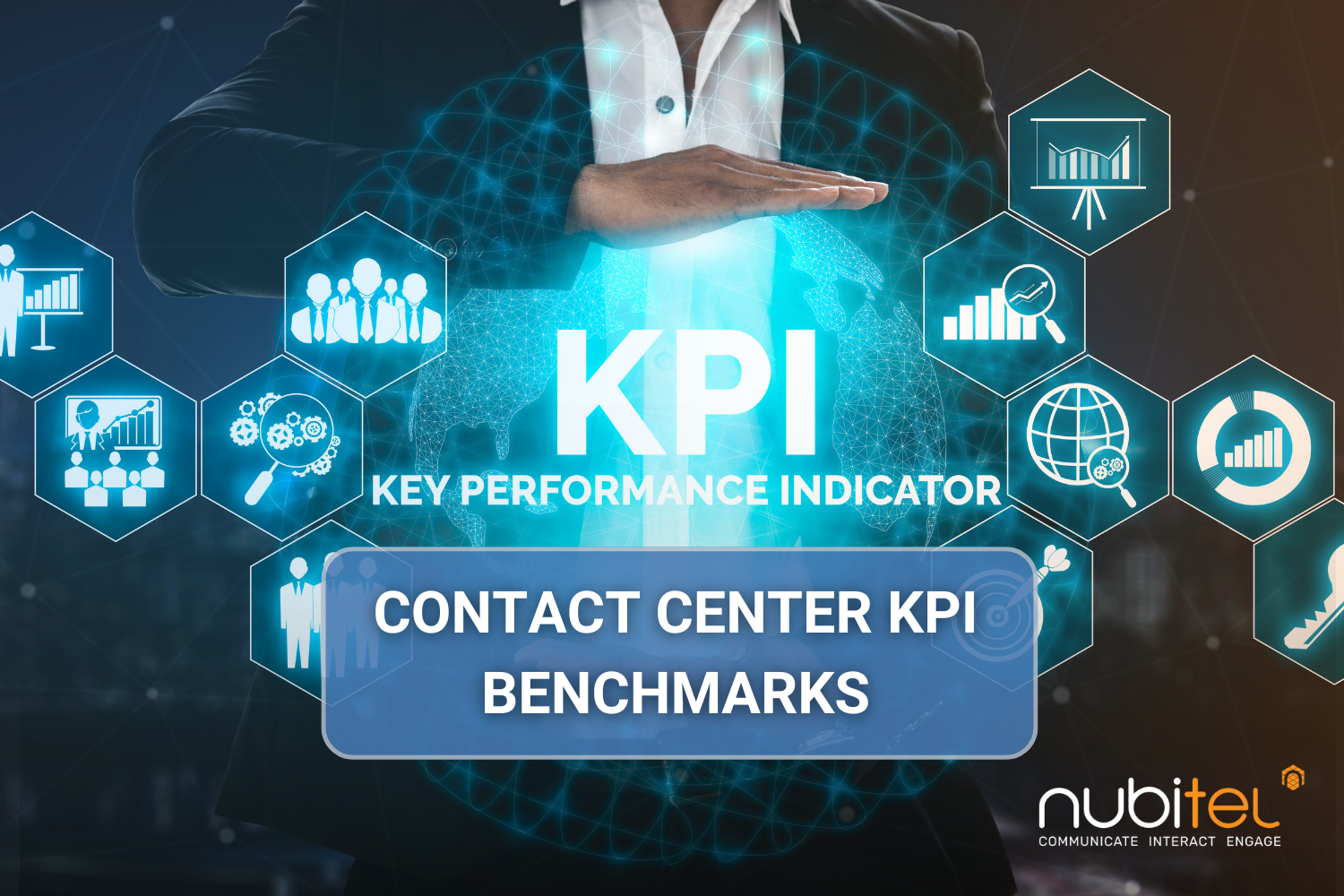In today’s competitive landscape, effective call center management is one of the key ways for maintaining customer satisfaction and operational efficiency. According to McKinsey & Company, 61% of customer care leaders have reported an increase in total call volumes, driven by a growing customer base and increased contacts per customer.
To navigate these challenges, understanding and monitoring Key Performance Indicators (KPIs) tailored to specific industries is essential. This article delves into the importance of KPIs in call centers, highlights key metrics to monitor, provides industry-specific benchmarks, and offers guidance on effectively utilizing these benchmarks to stay competitive in 2025.
Table of Contents
ToggleImportance of KPIs in Call Centers
KPIs provide measurable data to evaluate a call center’s performance in customer service, agent productivity, and operational efficiency. They help track progress toward business objectives and identify areas for improvement based on quantifiable metrics.
Failing to track and improve KPIs can lead to poor service quality, high customer churn, and increased operational costs. Thus, effective KPI monitoring helps businesses enhance service efficiency, boost customer loyalty, and maintain a competitive edge.
Key Call Center KPIs to Monitor
To maintain a high-performing call center, organizations must track key metrics that influence both customer experience and operational success. Below are the most critical KPIs that call centers should monitor:
1. First Call Resolution (FCR)
Measures the percentage of customer inquiries or issues resolved during the first interaction, reducing the need for follow-ups. Higher FCR rates indicate efficient problem-solving and improved customer satisfaction.
Industry Benchmark: 70% – 79%
2. Customer Satisfaction Score (CSAT)
Customer Satisfaction Score (CSAT) is another vital metric that measures how satisfied customers are with their service experience. Companies that consistently monitor CSAT can identify pain points in their support processes and refine customer interactions to boost retention and loyalty.
Industry Benchmark: 75% – 80%
3. Average Handle Time (AHT)
Represents the total time spent on a customer interaction, including talk time, hold time, and after-call work. A balanced AHT is essential for efficiency without compromising service quality.
Industry Benchmark: 6 minutes
4. Service Level
Indicates the percentage of inbound calls answered within a predefined timeframe (e.g., answering 80% of calls within 20 seconds). Maintaining a strong service level is crucial for customer retention and brand reputation.
Industry Benchmark: 80% of calls answered within 20 seconds
5. Call Abandonment Rate
Measures the percentage of customers who disconnect before speaking to an agent, often due to long wait times. A high abandonment rate signals staffing or queue management issues.
Industry Benchmark: 5% – 8%
Industry-Specific KPI Benchmarks
Different industries have unique customer service demands, requiring tailored KPI benchmarks. Below is a breakdown of KPI benchmarks by industry, along with real-world examples of leading companies implementing them effectively:
E-commerce and Retail
With increasing online transactions, e-commerce and retail call centers must provide swift and seamless customer support. Common KPIs include:
- First Call Resolution (FCR): 65% – 75%
- Average Handle Time (AHT): 4 – 6 minutes
- Customer Satisfaction Score (CSAT): 80% – 85%
Healthcare
Healthcare call centers handle sensitive inquiries, making accuracy and responsiveness key. Important benchmarks include:
- FCR: 75% – 85%
- AHT: 6 – 8 minutes
- Call Abandonment Rate: 3% – 5%
Financial Services
Banks and financial institutions require secure, efficient, and regulatory-compliant call center operations. Industry benchmarks include:
- FCR: 70% – 80%
- AHT: 5 – 7 minutes
- CSAT: 78% – 82%
Telecommunications
Telecom call centers handle billing inquiries, technical support, and service issues, requiring a balance of speed and accuracy. Key KPIs include:
- FCR: 65% – 75%
- AHT: 8 – 10 minutes
- Call Abandonment Rate: 6% – 9%
Travel and Hospitality
With fluctuating demand and high customer expectations, travel and hospitality call centers must focus on responsiveness and personalized service. Benchmarks include:
- FCR: 70% – 80%
- AHT: 3 – 5 minutes
- CSAT: 85% – 90%
How to Use KPI Benchmarks Effectively
Simply tracking KPIs is not enough. Organizations must analyze, interpret, and act on this data to drive continuous improvement. Effective KPI utilization ensures call centers stay agile, improve customer satisfaction, and optimize agent performance. Here are key strategies:
- Set Realistic and Actionable Goals: Use industry benchmarks as a guideline, but customize targets based on your call center’s specific operational constraints, service level agreements (SLAs), and customer demographics. For instance, a financial services call center may prioritize first call resolution (FCR) over average handle time (AHT) to ensure compliance with strict regulatory requirements.
- Leverage Advanced Technology: AI-powered conversational analytics, CRM integrations, and automated performance dashboards can provide real-time insights into KPI trends. These tools help predict customer demand, optimize agent scheduling, and identify inefficiencies before they impact service quality.
- Optimize Agent Training and Coaching: Regular performance reviews, AI-driven call monitoring, and personalized coaching plans are essential for developing agent skills. Focus areas should include both technical abilities and soft skills like communication and problem-solving. Agent assist provides real-time support to guide agents during calls, improving outcomes and satisfaction.
- Analyze Trends for Long-Term Improvements: KPIs should not be treated as isolated data points. By analyzing historical data and seasonal trends, you can anticipate fluctuations in performance and adjust accordingly. Reports and dashboards make it easier to track long-term trends, so you can make data-backed decisions about resource allocation and staffing.
By following these strategies, your call center can turn KPI benchmarks into actionable insights that improve customer experience, operational efficiency, and business performance.
Common Challenges in Meeting KPI Benchmarks
Although KPI benchmarking is essential, call centers often face challenges that make it difficult to meet their targets. Understanding these obstacles and addressing them proactively can make all the difference:
- Surging Call Volumes and Resource Constraints: Unforeseen events or seasonal spikes can overwhelm call centers, leading to longer hold times, higher abandonment rates, and lower customer satisfaction. To manage this, call centers can use tools like omnichannel routing and conversational IVR to balance call loads and ensure customers get timely assistance.
- Agent Burnout and High Turnover Rates: Repetitive tasks and demanding customer interactions can lead to agent burnout and high turnover. To combat this, call centers can integrate wellness programs, gamification, and incentives to keep agents engaged. Tools such as Agent Workbench provide agents with better tools to manage their workload, helping them perform more efficiently and with less stress.
- Limitations of Outdated Technology: Legacy systems often lack advanced analytics and seamless integrations, which can hamper efficiency. Upgrading to modern technologies is crucial. With unified communications and automation, businesses can scale easily, improve team collaboration, and boost overall productivity.
- Evolving Customer Expectations: Today’s customers expect seamless, personalized interactions across multiple channels—whether through phone, email, or live chat. Meeting these expectations requires an omnichannel approach and tools that provide real-time, personalized support. Offering support through live chat is a great way to provide fast and tailored assistance to customers.
By addressing these challenges with the right tools and strategies, call centers can stay on track with their KPI benchmarks and drive continuous improvement.
Conclusion
In 2025, strategic KPI benchmarking will be vital for call center success, influencing customer satisfaction, agent performance, and overall business efficiency. Organizations that actively monitor, analyze, and adapt their strategies based on data-driven insights will gain a competitive advantage.
By leveraging AI-driven analytics, enhancing agent training, adopting cloud-based solutions, and implementing an omnichannel approach, call centers can optimize operations, improve resolution rates, and maintain high service levels. As customer expectations evolve, businesses that embrace continuous innovation and data-backed decision-making will thrive in the ever-changing landscape of customer service.





